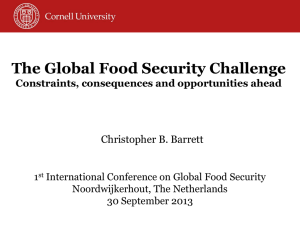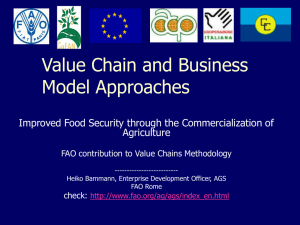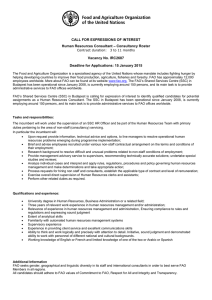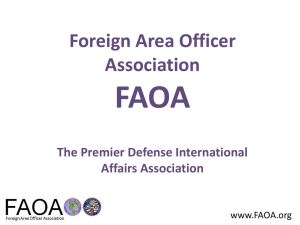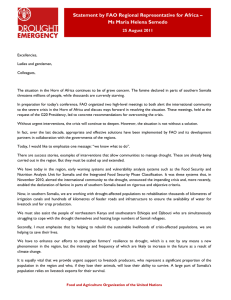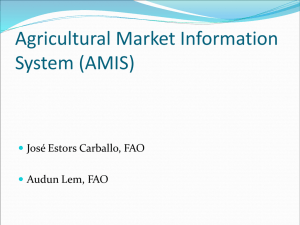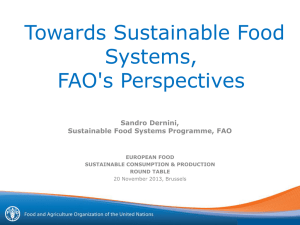2013
advertisement
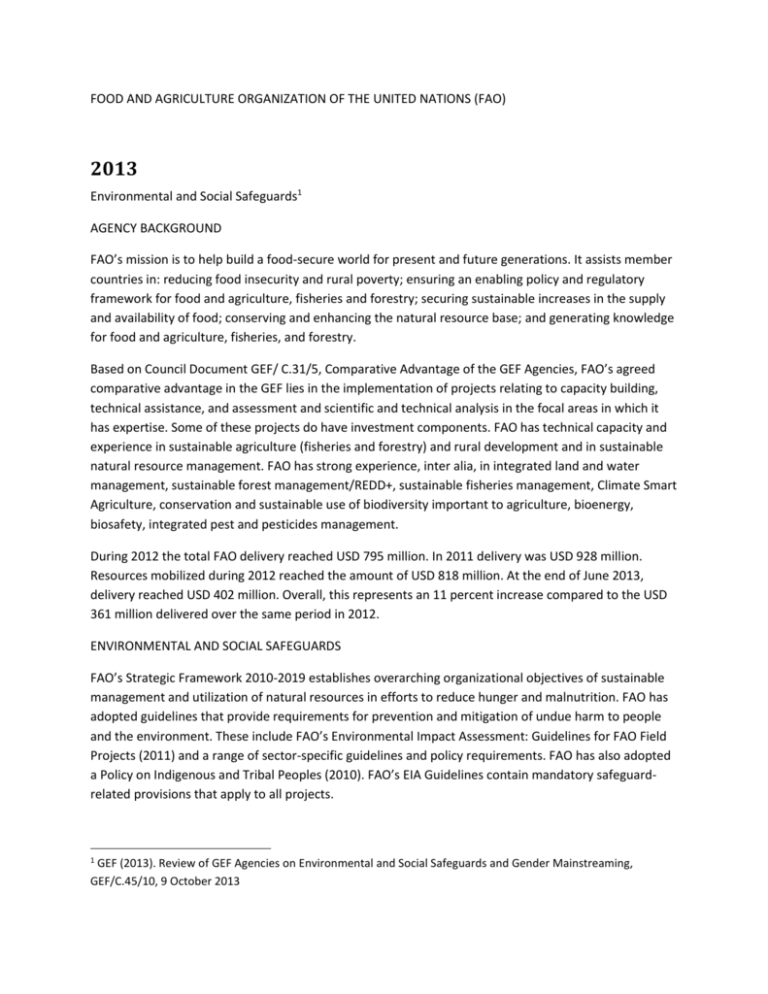
FOOD AND AGRICULTURE ORGANIZATION OF THE UNITED NATIONS (FAO) 2013 Environmental and Social Safeguards1 AGENCY BACKGROUND FAO’s mission is to help build a food-secure world for present and future generations. It assists member countries in: reducing food insecurity and rural poverty; ensuring an enabling policy and regulatory framework for food and agriculture, fisheries and forestry; securing sustainable increases in the supply and availability of food; conserving and enhancing the natural resource base; and generating knowledge for food and agriculture, fisheries, and forestry. Based on Council Document GEF/ C.31/5, Comparative Advantage of the GEF Agencies, FAO’s agreed comparative advantage in the GEF lies in the implementation of projects relating to capacity building, technical assistance, and assessment and scientific and technical analysis in the focal areas in which it has expertise. Some of these projects do have investment components. FAO has technical capacity and experience in sustainable agriculture (fisheries and forestry) and rural development and in sustainable natural resource management. FAO has strong experience, inter alia, in integrated land and water management, sustainable forest management/REDD+, sustainable fisheries management, Climate Smart Agriculture, conservation and sustainable use of biodiversity important to agriculture, bioenergy, biosafety, integrated pest and pesticides management. During 2012 the total FAO delivery reached USD 795 million. In 2011 delivery was USD 928 million. Resources mobilized during 2012 reached the amount of USD 818 million. At the end of June 2013, delivery reached USD 402 million. Overall, this represents an 11 percent increase compared to the USD 361 million delivered over the same period in 2012. ENVIRONMENTAL AND SOCIAL SAFEGUARDS FAO’s Strategic Framework 2010-2019 establishes overarching organizational objectives of sustainable management and utilization of natural resources in efforts to reduce hunger and malnutrition. FAO has adopted guidelines that provide requirements for prevention and mitigation of undue harm to people and the environment. These include FAO’s Environmental Impact Assessment: Guidelines for FAO Field Projects (2011) and a range of sector-specific guidelines and policy requirements. FAO has also adopted a Policy on Indigenous and Tribal Peoples (2010). FAO’s EIA Guidelines contain mandatory safeguardrelated provisions that apply to all projects. 1 GEF (2013). Review of GEF Agencies on Environmental and Social Safeguards and Gender Mainstreaming, GEF/C.45/10, 9 October 2013 These guidelines are relatively new and the Agency, given its focus on capacity building and technical assistance, has had few projects requiring full application of these requirements. FAO prohibits involuntary resettlement in its projects, including both involuntary physical and economic displacement, which requires FAO to develop voluntary approaches to addressing potential impacts caused by access restrictions to protected areas. FAO is currently considering approaches to strengthening its accountability and grievance redress systems. The agreed actions outlined below necessary for FAO to comply fully with the Minimum Standards will be incorporated into a time-bound action plan, which will be forwarded to the GEF Council by December 31, 2013. Minimum Standard 1: Environmental and Social Impact Assessment (ESIA) FAO meets most, but not all requirements of this Minimum Standard. FAO requires varying types and extent of environmental and social assessments for FAO-supported projects, scaled to risk levels, and project type. All projects are subject to screening for potential impacts and categorized. EIA Guidelines require integrated assessment of environmental and social impacts, with highest risk projects requiring a full EIA (inclusive of social dimensions). FAO’s mandatory guidelines address nearly all GEF requirements under this Minimum Standard. However, two areas require further strengthening: clarification of when use of independent expertise in high-risk projects is required, and its procedures for ensuring timely public disclosure of assessments and management plans. FAO has initiated a process to enhance its system of environmental and social safeguards and ensure full implementation consistent with the GEF’s Minimum Standards. As part of this initiative, FAO agrees to clarify its requirements regarding the use of independent expertise in the preparation of ESIAs and will implement a disclosure tracking system to strengthen implementation of its disclosure requirements. Minimum Standard 2: Natural Habitats FAO substantially meets this Minimum Standard. FAO’s EIA Guidelines require sustainable management, protection, conservation, and maintenance of natural habitats. FAO has multiple guidelines that support its approach to biodiversity conservation, forests, and fisheries. FAO employs a precautionary approach for projects involving protected areas or critical natural habitats and ecosystems. FAO’s policy requirements and mandatory guidelines address all the GEF requirements under this Minimum Standard except for ensuring timely disclosure of assessments and management plans (noted above). FAO will implement a disclosure tracking system to strengthen implementation of its disclosure requirements. Minimum Standard 3: Involuntary Resettlement FAO substantially meets this Minimum Standard. FAO has a clear policy prohibition against supporting projects that may involve involuntary physical relocation or economic displacement caused by land acquisition or loss of assets (including from access restrictions to protected areas). Given this prohibition, the GEF’s requirements regarding involuntary physical relocation and economic displacement do not apply to FAO. FAO, however, does implement projects concerning the creation or expansion of protected areas, which may involve imposition of access restrictions that may result in loss of income and/or livelihood impacts. FAO’s policy prohibitions indicate that it must pursue voluntary agreements for projects involving potential access restrictions; but, this approach is not reflected in FAO’s requirements with sufficient clarity. FAO will codify its approach of ensuring that conservation agreements/legal ownership agreements are reached with affected communities for protected area projects that may involve access restrictions. This will be included in revisions to its Environmental Impact Assessment Guidelines over the next year. Minimum Standard 4: Indigenous Peoples FAO meets most, but not all requirements of this Minimum Standard. FAO’s Policy on Indigenous and Tribal Peoples (PITP, 2010) and EIA Guidelines provide a framework for identification of indigenous peoples in project areas, avoidance or minimization of impacts on indigenous communities, and recognition of indigenous rights over lands and resources. Mitigation measures and determination of culturally appropriate benefits are to be identified through a process of free prior informed consent with affected indigenous peoples. FAO’s requirements address nearly all GEF requirements under this Minimum Standard. Two areas require strengthening: specification of the generic content and triggers for an Indigenous Peoples Plan, and ensuring timely disclosure of draft assessments and plans (including the Indigenous Peoples Plan). FAO agrees to specify the generic content of and triggers for requiring and Indigenous Peoples Plan when it updates its EIA Guidelines. FAO will implement a disclosure tracking system to strengthen implementation of its disclosure requirements. Minimum Standard 5: Pest Management FAO substantially meets this Minimum Standard. FAO’s EIA Guidelines and other guidelines provide a comprehensive framework for the avoidance of risks posed by pesticides and for promoting safe pest management practices. FAO’s requirements address all GEF requirements under this Minimum Standard except for ensuring timely disclosure of assessments and management plans. FAO will implement a disclosure tracking system to strengthen implementation of its disclosure requirements. Minimum Standard 6: Physical Cultural Resources FAO substantially meets this Minimum Standard. FAO’s EIA guidelines require that any projects that may have adverse impacts on or limit access to physical cultural resources (PCR) will be avoided. FAO seeks to enhance positive impacts through project design and site selection. FAO applies its EIA Guidelines to identify, avoid, mitigate, and mange potential impacts on PCR. FAO’s standards address all GEF requirements under this Minimum Standard except for ensuring timely disclosure of assessments and management plans. FAO will implement a disclosure tracking system to strengthen implementation of its disclosure requirements. Minimum Standard 7: Safety of Dams FAO substantially meets this Minimum Standard. FAO does not support large dams. It does support small dams and irrigation projects (in most cases, of no more than 5m in height or 50,000 cubic meters of storage). As such, several standards under the GEF requirements that relate to large dam projects are found inapplicable. FAO’s EIA Guidelines assess potential social and environmental risks of small dam projects. FAO applies a number of guidelines to ensure soundness and safety of small dam projects. These include FAO’s Manual on small earth dams and FAO Irrigation Guidelines (collection of eight separate guidelines). FAO’s mandatory guidelines address all relevant GEF requirements for small dams except for ensuring timely disclosure of assessments and management plans. FAO will implement a disclosure tracking system to strengthen implementation of its disclosure requirements. Minimum Standard 8: Accountability and Grievance Systems FAO does not meet this Minimum Standard. FAO country representatives may receive complaints regarding compliance of projects with FAO policies and procedures. Complainants may also address other FAO representatives if s/he feels satisfactory action has not been taken. FAO’s Office of Inspector General maintains a hotline for receiving complaints regarding breaches of regulations and rules. However, FAO does not have an accessible, transparent system in place for receiving, processing, and investigating external stakeholder complaints regarding breaches of FAO’s social and environmental policies. FAO also does not currently have an agency-wide grievance redress system for receiving, processing, and addressing external stakeholder complaints regarding social and environmental issues of FAO supported projects. FAO is reviewing other agencies’ practices and proposals for ensuring compliance review and grievance redress (including UNDP’s Proposal for Environmental and Social Compliance and Grievance Processes and among UN-REDD agencies). FAO plans to meet the GEF requirements under this Minimum Standard as part of its Action Plan. GENDER MAINSTREAMING The GEF Secretariat has assessed the FAO as meeting all of the minimum requirements of the GEF Policy on Gender Mainstreaming. The framework for FAO’s approach to gender mainstreaming its Policy on Gender Equality: Attaining Food Security Goals in Agriculture and Rural Development (referred to hereafter as “the Policy”), which was endorsed in March 2012. The goal of the Policy is to achieve gender equality in sustainable agricultural production and rural development for the elimination of hunger and poverty. The Policy includes a time frame for implementation, an accountability framework, and institutional mechanisms for implementation and oversight. This action is noted as being in line with intergovernmental mandates on gender mainstreaming. While FAO has just recently started implementing the policy in their reform process, it appears to have the capacity ensure gender mainstreaming in projects. FAO’s Gender Equality Strategy is specified in the Policy, describing that FAO works to address gender inequalities in two main ways: Gender mainstreaming - all FAO work will systematically examine and address women’s as well as men’s needs, priorities and experiences as part of the development of policies, normative standards, programs, projects, and knowledge building activities, so that inequality is not perpetuated. Women-specific targeted interventions - FAO will carry out programs and projects that specifically target women, in cases where the gender gap is so large that women have no access to available opportunities. FAO will implement a set of 13 minimum standards for ensuring gender mainstreaming in all its work and for targeted interventions by 2015. It will also institute a series of institutional mechanisms and processes to ensure the implementation of these minimum standards. FAO strives to improve its commitment to enhance gender equality objectives in the framework of the UN System-Wide Action Plan on Gender Equality and the Empowerment of Women (UN SWAP). FAO is the only GEF Agency to fully engage in this process. The Socio-economic and Gender Analysis (SEAGA) approach, developed in partnership with the International Labour Organization (ILO), the World Bank and the United Nations Development Program (UNDP), is used to develop the capacity of development specialists and humanitarian officers to incorporate socio-economic and gender analysis into development initiatives and rehabilitation interventions. SEAGA is incorporated into training programs and provides field workers, development planners and policy makers with practical tools including handbooks and guides on gender analysis in specific sectors. These delineate methodologies to ensure that projects, programs and policies are built in collaboration with beneficiaries and address the needs and priorities of both men and women and of disadvantaged people. FAO’s Office of Evaluation (OED) addresses gender equality as a standard criterion in all evaluations. The evaluation reports contain a dedicated section related to the extent to which gender issues were incorporated in the evaluated programs, projects or activities. One FAO best practice example to demonstrate to other Agencies would be the mainstreaming of gender in the Bay of Bengal Large Marine Ecosystem (BOBLME) Project which included a detailed gender audit and recommended actions for mainstreaming a gender perspective into the BOBLME project and its Strategic Action Programme (SAP).
